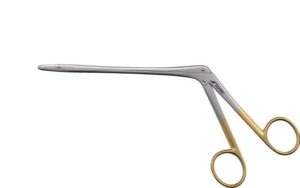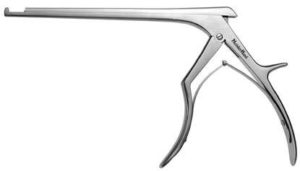Rongeurs instruments used mainly for removing the spinous process and boney prominent. Pituitary rongeur mainly used to remove the bone pinch by pinch, these will help surgeons to avoid damage to nerves and blood vessels. Depending on the number of bone removal essentials during a procedure.
Instruments with various jaws width and sharp according to the use. according to the indication and needs up cut and down cut rongeur are preferred and jaws also designed in the different angle of a degree to the better approach.
Depending on the procedure, a large amount of bone removal indicated. The rongeur point straight from the handle, while the duckbill points to the side. The Stille-Luer Horsley provides a 10 mm bite to remove bone while the Leksell and Duckbill are available in a variety of widths.
Types of Rongeur
types of the rongeurs mentioned here clearly
- Stille-Luer Horsley
- Leksell
- Duckbill
- Kerrison
Pituitary rongeur types
- Peapod pituitary
- Micro straight pituitary
- Casper serrated pituitary
- Micro Williams pituitary
Pituitary rongeur used to remove disc and tissue in small spaces.
- Used for straight, up, and down biting
- Available in several jaw widths, including 2 mm, 3 mm, and 4 mm.
- The proper length of the shaft to accommodate spinal procedures
Some rongeur, such as the Casper pituitary, have serrated jaws to help remove disc and tissue. Micro-discectomy procedures require the use of a microscope and three commonly used in these procedures to remove disc tissue: the micro straight pituitary, the Peapod pituitary, and the Micro Williams pituitary rongeur, commonly called “snaggle tooth”
Stille-Luer Horsley rongeur
It points straights from the handle and used in the laminectomy surgery
used to remove the spinous process like the boney projections on each vertebra where the muscles and ligaments attach to the spine.
Leksell and Duckbill rongeur used for the same purpose and in procedures
duckbill will have a slightly pointed side.
Kerrison rongeur
The Kerrison rongeur used to remove bone from smaller areas of the spine. Its features include Variable jaw widths, including 1 mm, 2 mm, 3 mm, 4 mm, and 5 mm. Two jaw slants (40o and 90 o), used for up or down biting (most commonly used one – up biting). Has a longer shaft length for spinal cases than shorter shaft instruments used for ear, nose, and throat (ENT) surgeries
The Stille-Luer Horsley and Leksell rongeur
The Stille-Luer Horsley and Leksell type point straight from the handle, while the duckbill points to the side. This provides a 10 mm bite to remove bone while the Leksell and Duckbill are available in a variety of widths.
Disinfection when dropped or unsterile use chemical sterilization
Sterilization of the Instruments by Steam sterilization
